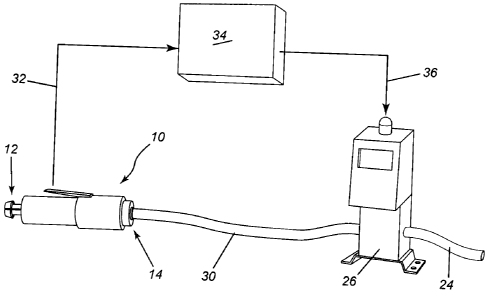Some of the information on this Web page has been provided by external sources. The Government of Canada is not responsible for the accuracy, reliability or currency of the information supplied by external sources. Users wishing to rely upon this information should consult directly with the source of the information. Content provided by external sources is not subject to official languages, privacy and accessibility requirements.
Any discrepancies in the text and image of the Claims and Abstract are due to differing posting times. Text of the Claims and Abstract are posted:
| (12) Patent: | (11) CA 2671684 |
|---|---|
| (54) English Title: | PEENING APPARATUS AND METHOD |
| (54) French Title: | APPAREIL A MARTELER ROTATIF ET METHODE |
| Status: | Granted |
| (51) International Patent Classification (IPC): |
|
|---|---|
| (72) Inventors : |
|
| (73) Owners : |
|
| (71) Applicants : |
|
| (74) Agent: | NORTON ROSE FULBRIGHT CANADA LLP/S.E.N.C.R.L., S.R.L. |
| (74) Associate agent: | |
| (45) Issued: | 2013-09-24 |
| (22) Filed Date: | 2009-07-13 |
| (41) Open to Public Inspection: | 2010-01-25 |
| Examination requested: | 2011-05-16 |
| Availability of licence: | N/A |
| (25) Language of filing: | English |
| Patent Cooperation Treaty (PCT): | No |
|---|
| (30) Application Priority Data: | ||||||
|---|---|---|---|---|---|---|
|
A method of peening a surface which comprises the steps of providing a rotary peening tool having at least one rotating flap mounted on the drive shaft which is rotatably driven, measuring the speed of the drive shaft, and controlling the speed of the drive shaft to maintain a desired level. A peening apparatus is also disclosed.
Une méthode de martèlement d'une surface qui comprend les étapes de fournir un outil à marteler rotatif ayant au moins un volet rotatif installé sur un arbre d'entraînement qui est entraîné par rotation, la mesure de la vitesse de l'arbre d'entraînement et le contrôle de la vitesse de l'arbre d'entraînement pour maintenir un niveau désiré. Un outil à marteler est également présenté.
Note: Claims are shown in the official language in which they were submitted.
Note: Descriptions are shown in the official language in which they were submitted.

For a clearer understanding of the status of the application/patent presented on this page, the site Disclaimer , as well as the definitions for Patent , Administrative Status , Maintenance Fee and Payment History should be consulted.
| Title | Date |
|---|---|
| Forecasted Issue Date | 2013-09-24 |
| (22) Filed | 2009-07-13 |
| (41) Open to Public Inspection | 2010-01-25 |
| Examination Requested | 2011-05-16 |
| (45) Issued | 2013-09-24 |
There is no abandonment history.
Last Payment of $624.00 was received on 2024-06-14
Upcoming maintenance fee amounts
| Description | Date | Amount |
|---|---|---|
| Next Payment if standard fee | 2025-07-14 | $624.00 if received in 2024 $651.46 if received in 2025 |
| Next Payment if small entity fee | 2025-07-14 | $253.00 if received in 2024 $264.13 if received in 2025 |
Note : If the full payment has not been received on or before the date indicated, a further fee may be required which may be one of the following
Patent fees are adjusted on the 1st of January every year. The amounts above are the current amounts if received by December 31 of the current year.
Please refer to the CIPO
Patent Fees
web page to see all current fee amounts.
| Fee Type | Anniversary Year | Due Date | Amount Paid | Paid Date |
|---|---|---|---|---|
| Application Fee | $200.00 | 2009-07-13 | ||
| Request for Examination | $800.00 | 2011-05-16 | ||
| Maintenance Fee - Application - New Act | 2 | 2011-07-13 | $100.00 | 2011-06-14 |
| Maintenance Fee - Application - New Act | 3 | 2012-07-13 | $100.00 | 2012-04-27 |
| Final Fee | $300.00 | 2013-05-06 | ||
| Maintenance Fee - Application - New Act | 4 | 2013-07-15 | $100.00 | 2013-07-12 |
| Maintenance Fee - Patent - New Act | 5 | 2014-07-14 | $200.00 | 2014-07-04 |
| Maintenance Fee - Patent - New Act | 6 | 2015-07-13 | $200.00 | 2015-05-01 |
| Maintenance Fee - Patent - New Act | 7 | 2016-07-13 | $200.00 | 2016-06-16 |
| Maintenance Fee - Patent - New Act | 8 | 2017-07-13 | $200.00 | 2017-04-25 |
| Maintenance Fee - Patent - New Act | 9 | 2018-07-13 | $200.00 | 2018-07-11 |
| Maintenance Fee - Patent - New Act | 10 | 2019-07-15 | $250.00 | 2019-04-24 |
| Maintenance Fee - Patent - New Act | 11 | 2020-07-13 | $250.00 | 2020-06-23 |
| Maintenance Fee - Patent - New Act | 12 | 2021-07-13 | $255.00 | 2021-04-16 |
| Maintenance Fee - Patent - New Act | 13 | 2022-07-13 | $254.49 | 2022-04-21 |
| Maintenance Fee - Patent - New Act | 14 | 2023-07-13 | $263.14 | 2023-05-17 |
| Maintenance Fee - Patent - New Act | 15 | 2024-07-15 | $624.00 | 2024-06-14 |
Note: Records showing the ownership history in alphabetical order.
| Current Owners on Record |
|---|
| FORGUES, SYLVAIN |
| LABELLE, BRIGITTE |
| Past Owners on Record |
|---|
| None |